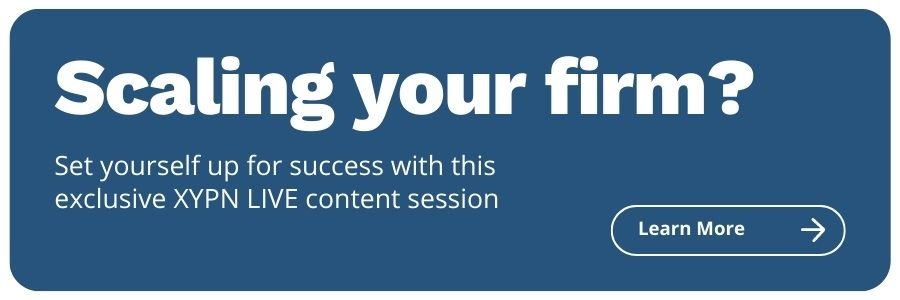Buying or Selling a Financial Planning Firm? Here's What You Need to Know
Share this
The topic of succession planning has been top of mind in the financial industry for years as the average age of advisors continues to increase and the industry as a whole struggles to attract the next generation of talent.
Succession planning creates a unique opportunity for younger advisors who are looking to grow their business through an acquisition while offering seasoned advisors approaching retirement an opportunity to provide continued service to their clients and receive compensation for the business they have built.
Buyers and sellers in a succession plan each have a number of considerations—who is the right partner; what’s the scope of the purchase; how do you structure the sale? This blog will cover each of these considerations in detail.
Let’s start with considerations for the buyer and seller in finding the right partner. This is often the most difficult part of setting up a succession plan. If you ask advisors why they haven’t set up a succession plan, many times they have either been in an agreement that ultimately didn’t work or they have been unable to find someone they feel can take over their business.
Before getting into the business model, it's important to start with business and personal values and vision. If these don’t align, the succession plan is likely doomed from the start. The buyer and seller don’t have to agree on everything, but understanding where the business came from and having a common vision for the future will help build the trust that is needed for a successful buyer-seller relationship.
Think about the core values of the advisors, clients, and firms—do they align? Once you have this alignment, you can move to the business considerations. First, does the buyer have the expertise to serve the seller's existing clients? If the seller serves small business owners and the buyer primarily works with teachers, these are very different markets with different needs. If the buyer doesn’t have the expertise, can that knowledge be transferred and if so, how and at what cost?
The next area to consider is how services are being provided. In a fee-only firm, the buyer and seller may both be providing financial planning and asset management. However, if the seller is providing one-time plans and managing client portfolios themself and the buyer is providing ongoing planning services and outsourcing portfolio management to a TAMP, these are very different business models. These businesses could be combined and clients could be transitioned from advisor-managed portfolios to a TAMP, however, fees and client attrition would have to be taken into consideration.
Fee structures should also be discussed as part of the business model conversation. Many firms considering a merger or succession plan have different fee structures. The buyer and seller have multiple options, such as merging to one fee structure, keeping all existing clients as is and onboarding new clients under the new fee structure, or running multiple fee structures. Ultimately when evaluating these options, advisors need to consider what is right for the clients, if the fee structure aligns with the services being provided, and what makes sense for the business.
This gets more complicated if an RIA is looking to purchase a business that has broker-dealer accounts. Are those accounts excluded from the purchase? Is there a way to maintain the client relationship and continue to provide advice to those clients? If it’s determined this is still a good fit, it is good practice to establish an NDA between the buyer and seller and start to do more detailed due diligence. That includes, but is not limited to, a regulatory review, business review (a minimum of the past three years), employee review, client/revenue numbers, any vendor contracts, and what technology is being used.
Once you have alignment on business philosophy and business model and have done your due diligence, it's time to jump into the scope of the purchase and what could be included in the sale of the business. To start, ask this question: will the entity be sold with the business as an equity purchase or are just the assets (client relationships) sold as an asset purchase? If a seller and buyer actually want the seller’s entity itself to transfer to the ownership/control of the buyer, additional legal, tax, and securities law considerations need to be taken into account.
Buyers of an entity itself (as opposed to simply the assets of an entity) should also be aware of any liabilities they will assume by virtue of acquiring all or substantially all the equity of an entity. Once this has been determined, the buyer and seller should review revenue and expenses to determine what are included in the sale. This includes any vendor contracts, leases, etc. The buyer and seller should discuss all property, including client agreements, marketing names/materials, office equipment, real estate, and intellectual property.
Finally, a determination should be made of the role the seller will have in the transition. There are a few options here, such as simply selling and introducing the clients to the buyer. This option is the simplest, but in some cases may increase the client attrition risk. Another option is for the buyer to pay the seller a consulting fee for a determined amount of time (3-6 months) to help with the transition; this way they can meet jointly with the clients and discuss how this change will impact them. This increases client retention and also increases compensation to the seller.
Now that the buyer and seller have determined the business model is a fit and what's included in the purchase, it's time to put the terms of the agreement in place. If you haven’t engaged an attorney up until this point, now is the time to do so. In some cases, the buyer and seller will enter into a letter of undertaking (LOU) prior to the implementation of the buy-sell agreement. This LOU serves the purpose of laying out the terms of the agreement.
Some of the considerations that the buyer and seller will want to each have laid out in the LOU include what their responsibilities are leading up to the agreement and what they must do at the time of the agreement. From the perspective of the seller, this could be transferring the assets that were agreed upon in the scope of the sale, a detailed inventory list, agreeing to relinquish rights to all fees generated after a certain date, signing over agreements to the buyer, and so on. From the perspective of the buyer, this could include taking over leases and other expenses on a specified date, as well as details on how and when compensation payments will be made to the seller for the business. The structure of the sale will determine the type of agreement that the buyer and seller use.
Regardless of the agreement type, you should include details about how the purchase price is determined and how it will be paid. Generally there are three ways to fund a purchase: down payment, promissory note, and earn out. In many cases, the agreement will be structured with multiple components built in. Each component of the purchase price should be detailed to include how it's calculated, when it's paid, and if there are any contingencies attached.
Many times, the buyer and seller will build contingencies or look-backs into the deal to account for client attrition and increased/decreased revenue. Other considerations in the terms of the agreement include non-competes/non-solicits, confidentiality, and indemnification.
Succession planning can be an intimidating process, but if done correctly, it can be a rewarding experience for both the buyer and seller. Not only will the seller receive compensation for the business they have built, but they will ensure that the legacy they have established will last well beyond them. They will also know that the clients they served will continue to receive the service and advice they deserve for generations to come. The buyer will have the opportunity to not just grow their business, but be part of the next generation of financial advice and in turn start to build their own business and legacy.
 About the Author
About the Author
As XYPN's Director of Advisor Success, Malcolm is tasked with doing just that—helping advisors succeed. After graduating from Gettysburg College with a B.A in Management, Malcolm jumped straight into the financial services industry and never looked back. With a drive to help shape the future of financial planning and a passion for bringing financial advice to the next generation of clients, he has a lot in common with the advisors in the Network.
Share this
- Advisor Blog (721)
- Financial Advisors (244)
- Growing an RIA (128)
- Business Development (95)
- Digital Marketing (95)
- Marketing (92)
- Community (82)
- Start an RIA (76)
- Coaching (74)
- Running an RIA (72)
- Compliance (70)
- Client Acquisition (68)
- Technology (67)
- Entrepreneurship (64)
- XYPN LIVE (64)
- Fee-only advisor (49)
- Sales (49)
- Bookkeeping (46)
- Client Engagement (45)
- Practice Management (44)
- XYPN Books (43)
- Scaling an RIA (42)
- Investment Management (41)
- Client Services (31)
- Employee Engagement (31)
- Financial Education & Resources (31)
- Lifestyle, Family, & Personal Finance (31)
- Market Trends (26)
- Journey Makers (24)
- Process (18)
- Niche (13)
- SEO (9)
- Career Change (8)
- Partnership (8)
- Transitioning Your Business (7)
- Sapphire (6)
- Persona (4)
- Transitioning To Fee-Only (4)
- Emerald (3)
- Social Media (3)
- Transitioning Clients (3)
- RIA (2)
- Onboarding (1)
Subscribe by email
You May Also Like
These Related Stories

Business Considerations For Firm Owners During Tough Times
Mar 30, 2020
6 min read

Planning for Your First 12 Months after Starting an RIA: Part One
Feb 25, 2019
12 min read
-1.png?width=360&height=188&name=Reaching%20for%20Yield%20A%20Careful%20Analysis%20(1)-1.png)





